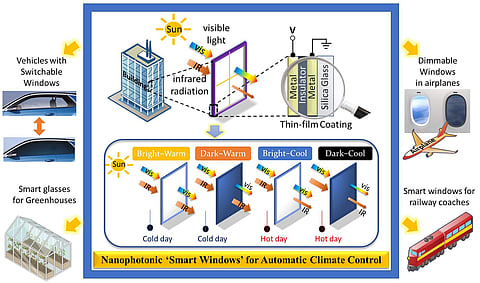

IIT Guwahati researchers have developed a smart window material that can effectively control the amount of heat and light passing through it in response to an applied voltage. This material can help in developing automatic climate control systems in buildings. Dr Debabrata Sikdar, Assistant Professor, Department of Electronics and Electrical Engineering, along with research scholar, Ashish Kumar Chowdhary at the institute designed this and the result of their study was recently published in the journal, Solar Energy Materials and Solar Cells.
Conventionally, window designs are static, and they are predesigned for specific climatic conditions. The emergent smart windows, on the other hand, can dynamically adjust the amount of light and heat radiation entering a building in response to external stimuli, thus conserving the building’s energy. The design of smart windows that are adjustable for all-weather conditions is challenging. The IIT Guwahati team has designed smart window ‘glasses’ using noble metals as well as their relatively inexpensive alternatives that can dynamically control the intensity of transmitted solar radiation, depending upon the weather or climate condition. "There has been increased attention to sustainable architectural designs for better light and heat management in buildings in recent years, and deploying smart windows is the first step for such structures," said Dr Sikdar.
"We have proposed an electro-tuneable glass made of two ultra-thin metal layers sandwiching an electro-optic polymer whose refractive index can be changed by applying a small voltage, which allows filtering of visible and infrared radiation," explained Chowdhary.
The researchers used this design to perform simulation studies to understand the light and heat transmission properties in response to the applied voltage. They initially considered gold and silver as the metal layers, but later tested their model with cheaper alternatives such as copper and transparent semiconductor such as indium tin oxide. When the researchers simulated the application of a bias voltage ranging from −15 V to +15 V across this sandwich structure using Finite Element Methods, the smart glass could selectively filter solar radiation, spanning the visible, infrared and shortwave infrared wavelengths. The simulation also showed that this material reflected mid-wave infrared, long-wave infrared (LWIR; 8–15 μm), and a part of far-infrared wavelengths thereby providing insulation from heat and light reflected from neighbouring buildings and structures.
"At present, the COVID-19 pandemic has imposed an unprecedented risk of cross-infection through aerosols transmission in public buildings such as healthcare centres, offices, transportation systems, workshops, laboratories and food storage facilities etc, where central air-conditioning systems are in use. We believe that our smart windows can provide an alternative solution for maintaining ambient indoor temperature and lighting inside a building or a vehicle by integrating those with usual glass windows or walls, thereby reducing the need for air-conditioning systems," added Dr Sikdar.
These smart glasses developed by the IIT Guwahati researchers can also be applied to efficient automatic climate control in vehicles, locomotives, aeroplanes and greenhouses of the future.
